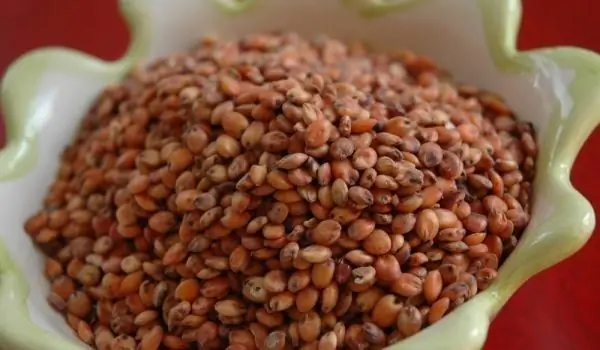2025 Author: Jasmine Walkman | [email protected]. Last modified: 2025-01-23 10:18
Sorghum / Sorghum / is a genus of herbaceous plants of the Cereal family. Sorghum is also known as butterbur, broom, broom and Tatar. The genus includes between 60-70 species of wild plants, as well as a number of domesticated species and even more hybrids and varieties.
Sorghum is a tropical plant that originated in Africa and later spread to southern European countries. It is often called "drought-resistant corn". Sorghum has a smaller leaf mass, which makes it suitable for growing in very dry areas.
Sorghum has a strong root system, which explains its drought resistance. The leaves and stems are covered with a waxy coating. The stem has nodes and internodes, there are two types sorghum - stems up to 2-5 meters high and low stems - up to 1.5 meters. The leaves are thin, with a small length of the stomata, which close in drought and reopen when the plant regains its turgor.
Sorghum is one of the oldest cultivated plants, but there is no consensus on its origin. According to some researchers, his homeland is India, according to others - Equatorial Africa, and according to others - China. Sorghum is not new to our country. By the middle of the 19th century, technical and sugar products were imported almost simultaneously sorghum.

Growing sorghum
Good predecessors for growing sorghum are winter and spring cereals with a fused surface. However, sorghum dries out the soil, making it a poor precursor to winter cereals. Immediately after harvesting the predecessor, the soil should be plowed to a depth of 20-25 cm.
Pre-sowing tillage begins with spring harrowing, and when weeding it is cultivated to a depth of 12 cm. Before sowing the sorghum, a second cultivation is carried out at a depth of 6-8 cm. It is best to level the area because the sorghum seeds are small and are sown at a shallow depth.
Sorghum responds well to fertilization. The greatest effect is nitrogen fertilization. The plant is sown in late April and early May. A row spacing of 60-70 cm should be left.
Sorghum is harvested at technical maturity, when the grain reaches the typical color of the hybrid and humidity of about 14-15%. Harvesting is usually done in September-October. Long-term storage of grain is carried out at a humidity of 13%. Ordinary sorghum is harvested in the phase of milk maturity, and sugar - in the phase of wax maturity.
Composition of sorghum
The nutritional value of sorghum is very close to that of corn. Since 1990, all hybrids in Europe have a 0% tannin content. Studies show that sorghum contains more starch and protein and less fat than corn.
Types of sorghum
Sorghum for grain - this variety of sorghum has very high productive potential. Modern hybrids give about 800 kg / dca.

Sugar broom - in our country it is grown by amateurs. The syrup from such a broom can not ferment, but is a good raw material for homemade sweetener.
Technical broom - in our country this sorghum was widely used for making brooms. The areas on which it was grown were very spacious.
Sudan - fodder crop which has been cultivated for the production of grain, green fodder or silage.
Use of sorghum
Most species sorghum are used for food, feed, biofuels, cosmetics and even for the production of alcoholic beverages. From some varieties of sorghum are made thatched roofs and fences, brooms, baskets, brushes.
Until a few years ago, sorghum was a major substitute for wheat in flour production in northern China. In some parts of India, unleavened sorghum bread is still a staple food to this day. In South Africa, sorghum is used to make a thick paste, it is also used to make beer, and even sorghum beer is considered a traditional Zulu drink.
Sorghum can be used as a substitute for rice garnish. To do this, mix 1 tsp. Peeled grain with 2 to 4 parts water in a large saucepan. Cover and leave to soak overnight. The next day, boil the sour beans.
Recommended:
What Is Sorghum And What To Cook With It

Sorghum is a protein-rich grain with a millet-like texture. In the United States, farmers use sorghum for livestock feed. In Africa and Asia, people use it in dishes such as oatmeal and bread. Sorghum is a good alternative to food for people who are sensitive to gluten - a protein found in foods such as wheat, rye and barley, as it does not contain gluten and can serve as a substitute for wheat.
How To Cook Quinoa, Amaranth And Sorghum

Quinoa is called the queen of cereals. It contains valuable amino acids and has a high protein content. Kyonoa seeds are a great substitute for rice, couscous or bulgur. Before cooking, the beans should be poured into a colander with small holes.

